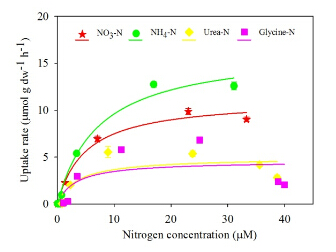Largemacroalgalblooms (also known as green tides, orUlva prolifera) occurred in the southern Yellow Sea, China, yearly from 2008 to 2015. Since 2008, green tides have become a severe problem with negative impacts on the coastal ecosystem of the southern Yellow Sea. It even affected the hosting of the 2008 Olympic Games in the local city of Qingdao, and caused a great economic loss.
Previous studies have shown thatUlva proliferais the most dominant green-tide-forming species in the southern Yellow Sea. Laboratory experiments show thatUlva proliferarapidly assimilates dissolved inorganic N and P, however, the uptake of organic P and N byUlva proliferahas seldom been investigated in the laboratory.
A collaborative research team, led by Prof. ZHANG Yongyu from the Chinese Academy of Sciences' Qingdao Institute of Bioenergy and Bioprocess Technology (QIBEBT), made progress in studying mechanisms of the macroalgal blooms. By revealing thegrowth responses ofUlva proliferato varied inorganic and organic nutrients, several implications for macroalgal blooms in the southern Yellow Seahave been demonstrated.
The discharge of nutrient-rich wastewater from rivers and aquaculture ponds will supply organic and inorganic nutrients to nearshore coastal waters. These nutrients play key roles in the rapid development of green tides. The present study is conducted by using different species of nutrients (such as urea, or glycine from aquaculture feed).
Our results indicated that organic nutrients may contribute to the outbreak of macroalgal blooms in the southern Yellow Sea. This suggests that controlling the discharge of organic nutrients, such as unused feed and organic excreta from rivers and mariculture ponds, may reduce the annual occurrence of harmful green tides in the southern Yellow Sea.
The study was collaborated with Prof. SHI Xiaoyong from the Ocean University of China and the National Marine Hazard Mitigation Service, Prof. Richard B. RIVKIN from the Memorial University of Newfoundland, and Prof. Louis LEGENDRE from UPMC Université Paris. Moreover, Prof. RIVKIN (Canada) and Prof. LEGENDRE (France) were financially supported by the CAS President’s International Fellowship Initiative (PIFI).

Figure 1. Concentration-dependent uptake rates of the four nitrogen substrates by U. prolifera during the first eight days (192 h) of the experiment. Dots: uptake rates. (Image by QIBEBT)
Reference:
Growth responses ofUlva proliferato inorganic and organic nutrients: Implications for macroalgal blooms in the southern Yellow Sea, China,Sci. Rep.,2016,doi: 10.1038/srep26498
Contacts: Prof. ZHANG Yongyu; Prof. SHI Xiaoyong
Qingdao Institute of Bioenergy and Bioprocess Technology, Chinese Academy of Sciences;Ocean University of China
Email: zhangyy@qibebt.ac.cn; shixy@ouc.edu.cn